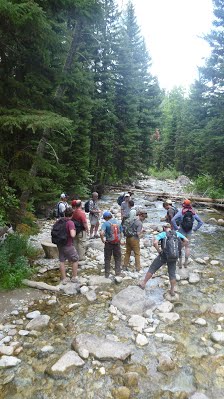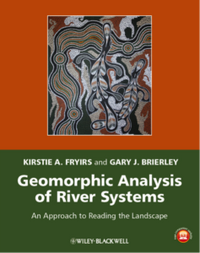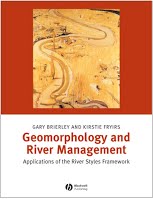WATS 5150 - Syllabus
Catalog Description
 This course focuses on an introduction to fluvial geomorphology through teaching students to read landscapes and riverscapes. Students will develop an appreciation of riverscape diversity, in which distinctive suites of physical and biotic processes (behavior) help shape the form and character of those landscapes. Weekend field trips are required.
This course focuses on an introduction to fluvial geomorphology through teaching students to read landscapes and riverscapes. Students will develop an appreciation of riverscape diversity, in which distinctive suites of physical and biotic processes (behavior) help shape the form and character of those landscapes. Weekend field trips are required.
| Semester(s) Traditionally Offered | Spring |
| Credits: | 3.000 Credit hours |
| Levels: | Graduate, Undergraduate |
| Schedule Types: | Hybrid Face to Face Lecture |
| Cross-Listed As: | WATS 6150 GEO 5150/6150 CEWA 6510 |
| Pre-requisites | For Undergraduates: WATS 3600 (Geomorphology) and WATS 4490 (Small Watershed Hydrology). There is no prerequiste for graduate students and students taking the course for CEU |
Schedule
This course will typically be taught every Spring (pending adequate demand). The first revamped version of the class was taught in Spring 2021 and again was taught in Spring 2022. This version of Fluvial was not taught in 2023 while Joe was on sabbatical. The current class is being taught Spring 2024 semester.
Past Versions
Past versions of the course give an idea of the schedule, syllabus and work the previous cohorts of students undertook.
for More Details See Spring 2021
Schedule & Syllabus See Spring 2022
Schedule & Syllabus
Fees
USU Students - USU tuition & $150 Field Trips course fee. Non-USU Students - $945
Course Objectives

By the end of this course, you will be able to:
- Confidently read any riverscape and be able to map its core characteristics.
- Differentiate influence of external controls (e.g., climate and catchment) vs. local controls on form and process.
- Apply principles of geomorphic analysis to a diversity of riverscapes.
- Recognize the primary controls on riverscape diversity, in which distinctive suites of physical and biotic processes (behavior) help shape the form and character of those landscapes.
- Understand how hydrologic processes, give rise to hydraulic processes, which in local riverscapes determine the rates, magnitudes and occurece of fluvial geomorphic proceses.
- Appreciate that topography is a quantitative record of landforms and apply morphometric analysis can be used to map and differentiate those landforms (i.e., geomorphic units).
- Gain an appreciation of how geomorphic processes of erosion, deposition transport and storage of sediment shape topography and create, maintain, sculpt and destroy distinctive landforms.
- Understand human impacts on riverscapes and fluvial forces.
- Recognize how geomorphic analysis is used in practice to help manage riverscapes.
Course Resources
Required and Optional Course Resources (e.g., textbook, safety equipment, etc.).
Course Textbook
Mandatory Text - A hard copy of the required text book is strongly suggested. You can view the text digitally through the library’s Ebook Central.
Fyirs & Brierley (2013)
 Fryirs KA, Brierley GA. 2013. Geomorphic Analysis of River Systems: An Approach to Reading the Landscape, First Edition. Blackwell Publishing Ltd.: Chichester, U.K.
Fryirs KA, Brierley GA. 2013. Geomorphic Analysis of River Systems: An Approach to Reading the Landscape, First Edition. Blackwell Publishing Ltd.: Chichester, U.K.
To view through the library by Chapter:
- CHAPTER ONE: Geomorphic analysis of river systems: an approach to reading the landscape
- CHAPTER TWO: Key concepts in river geomorphology
- CHAPTER THREE: Catchment-scale controls on river geomorphology
- CHAPTER FOUR: Catchment hydrology
- CHAPTER FIVE: Impelling and resisting forces in river systems
- CHAPTER SIX: Sediment movement and deposition in river systems
- CHAPTER SEVEN: Channel geometry
- CHAPTER EIGHT: Instream geomorphic units
- CHAPTER NINE: Floodplain forms and processes
- CHAPTER TEN: River diversity
- CHAPTER ELEVEN: River behaviour
- CHAPTER TWELVE: River evolution
- CHAPTER THIRTEEN: Human impacts on river systems
- CHAPTER FOURTEEN: Sediment flux at the catchment scale: source-to-sink relationships
- CHAPTER FIFTEEN: The usefulness of river geomorphology: reading the landscape in practice
See also the Student Companion website for the book.
Brierley & Fryirs (2005) - Optional
This is the so-called “River-Styles” text book and is a helpful follow up reference (not required)

- Brierley, G., and K. Fryirs 2005. Geomorphology and River Management: Applications of the River Styles Framework. Blackwell Publishing, Victoria, Australia.
Grade Scheme
The following grading standards will be used in this class:
| Grade | Range |
|---|---|
| A | 100 % to 93.0% |
| A- | < 93.0 % to 90.0% |
| B+ | < 90.0 % to 87.0% |
| B | < 87.0 % to 83.0% |
| B- | < 83.0 % to 80.0% |
| C+ | < 80.0 % to 77.0% |
| C | < 77.0 % to 73.0% |
| C- | < 73.0 % to 70.0% |
| D+ | < 70.0 % to 67.0% |
| D | < 67.0 % to 60.0% |
| F | < 59.0 % to 0.0% |
Library Services
All USU students attending classes in Logan, at our Regional Campuses, or online can access all databases, e-journals, and e-books regardless of location. Additionally, the library will mail printed books to students, at no charge to them. Students can also borrow books from any Utah academic library. Take advantage of all library services and learn more at libguides.usu.edu/rc. (Links to an external site.)
University Policies that Apply to this Class
Please visit the Canvas Syallabus page for upto date University Policies (e.g. for 2024).